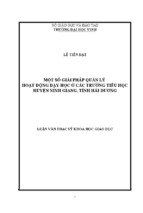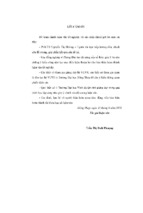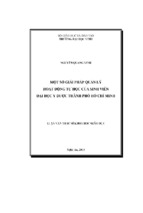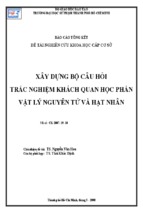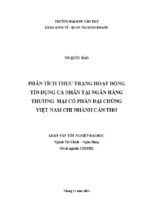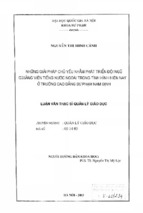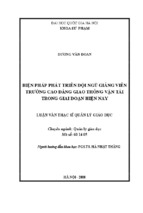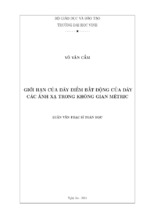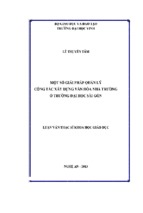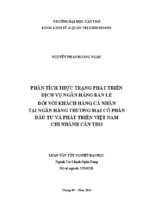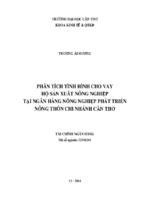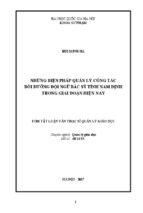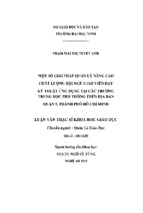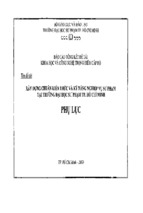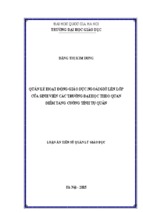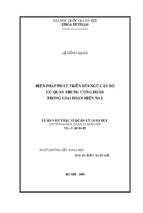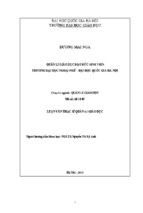MINISTRY OF EDUCATION AND TRAINING
VINH UNIVERSITY
LÂM THỊ HƯƠNG
IMPROVING SPEAKING SKILL FOR 10TH GRADE
STUDENTS AT DO LUONG 1 HIGH SCHOOL THROUGH
COMMUNICATIVE ACTIVITIES
MASTER THESIS IN EDUCATION
Nghe An - 2014
MINISTRY OF EDUCATION AND TRAINING
VINH UNIVERSITY
LÂM THỊ HƯƠNG
IMPROVING SPEAKING SKILL FOR 10TH GRADE
STUDENTS AT DO LUONG 1 HIGH SCHOOL THROUGH
COMMUNICATIVE ACTIVITIES
Major: Teaching English to Speakers of Other Languages (TESOL)
Code: 60.140.111
MASTER THESIS IN EDUCATION
SUPERVISOR: TRẦN BÁ TIẾN, Ph.D.
Nghe An – 2014
STATEMENT OF AUTHORSHIP
I hereby acknowledge that this study is mine. The data and findings
discussed in the thesis are true, used with permission from associates, and have not
been published elsewhere.
Author
Lam Thi Huong
AcknowleDgementS
Firstly, I would like to express my sincerest gratitude to my supervisor Dr
Tran Ba Tien who has helped me with his precious knowledge, assistance, and
support during the process of writing.
i
Secondly, I truly wish to thank the teachers at Do Luong 1 High School where
my investigation was carried out for their useful materials, valuable advice and
great cooperation.
In addition, I also like to send my special thanks to all students at Do Luong 1
for their willingness to answer my questionnaires.
Last but not least, my sincere thanks are due to my dear family and my friends
who always stand for me with their consideration and encouragements.
ABSTRACT
This research is concerned about the difficulties encountered in teaching English
and some communicative activities are suggested to improve speaking skill for the
10th grader students at Do Luong 1. Survey questionnaires, interview and class
ii
observation for teachers and students are employed to find the answers to the
questions. From the results of the study, the researcher gets a view on specific
situation of using communicative activities to improve speaking skill for 10th
graders at Do Luong 1 high school. The study has found out some difficulties that
the teachers and students are facing in their speaking lessons. In addition to, the
researcher also suggest some recommendations in applying communicative
activities to develop speaking skill successfully for their 10th graders. The author
hopes that the study will help teachers to overcome the difficulties in teaching and
learning English speaking skill at Do Luong 1 high school as well as a reference
for those who are interested in this matter.
TABLE OF CONTENTS
STATEMENT OF AUTHORSHIP............................................................................0
Acknowlegement............................................................................................ii
ABSTRACT.............................................................................................................iii
iii
LIST OF ABBREVIATIONS.................................................................................viii
CHAPTER 1. INTRODUCTION..............................................................................1
1.1. Rationale.............................................................................................................1
1.2. Objectives of the study........................................................................................2
1.3. Research questions................................................................................................2
1.3.1. What is the real situation of teaching and learning speaking skill of the 10th
graders at Do L uong 1 high School, Doluong District, Nghe An Province ?..................2
1.3.2. How are communicative activities applied in speaking lessons for the 10th
graders at Do Luong 1 high school?...........................................................................2
1.3.3. What are suggested class communicative activities to improve for the 10th
graders’ speaking skill in Do Luong 1 high school?.................................................2
1.4. Scope of the study..............................................................................................2
1.5. The design of the study.....................................................................................2
CHAPTER 2. THEORETICAL BACKGROUND....................................................4
2.1 The nature of language skills...............................................................................4
2.2 Speaking skill.......................................................................................................4
2.2.1 The definitions of speaking skill......................................................................4
2.2.2 The importance of teaching speaking................................................................5
2.2.3 Principles for teaching speaking skill..................................................................6
2.2.4 Stages for teaching speaking skill.....................................................................7
2.2.5 Problems with speaking activities.....................................................................8
2.3 Communicative language teaching aproach........................................................9
2.3.1 Concepts of CLT...............................................................................................9
2.3.2 Characteristics of CLT....................................................................................10
2.4. Communicative activities..................................................................................11
2.4.1. Aims of communicative activities..................................................................11
2.4.2 Characteristics of communicative activities....................................................11
2.4.3 Types of oral communicative activities...........................................................12
2.4.4 Roles of communicative activities in language teaching and learning...........17
2.4.5 Requirements of communicative activities......................................................21
CHAPTER 3. METHODOLOGY...........................................................................23
iv
3.1. Research setting................................................................................................23
3.1.1 An overview of Do Luong 1 high school......................................................23
3.1.2.The teachers....................................................................................................23
3.1.3. The students...................................................................................................24
3.1.4 The syllabus...................................................................................................24
3.1.5 The current situation of teaching and learning speaking skill at Do Luong 1.
................................................................................................................................. 25
3.2 Research method...............................................................................................26
3.2.1 Methods.........................................................................................................26
3.2.2 Data collection instruments.............................................................................27
3.2.2.1 Survey questionnaire....................................................................................27
3.2.2.2 Classroom observation.................................................................................27
3.2.2.3 Interviews.....................................................................................................27
3.3 Procedures..........................................................................................................28
CHAPTER 4. FIDINGS AND DISCUSSION.........................................................29
4.1 Data analysis......................................................................................................29
4.1.1 Results of students’ survey questionnaire.......................................................29
4.1.1.1. Students’ background of learning English...................................................29
4.1.1.2 Students’ reasons for learning English.........................................................30
4.1.1.3 Students’ attitudes towards learning speaking skill......................................31
4.1.1.4 Factors that make the students difficult to speak..........................................32
4.1.1.5 Students’ attitudes towards communicative activities..................................34
4.1.1.6 Students’ difficulties in practising communicative activities.......................35
4.1.2 Results of teachers’ survey questionnaire.......................................................35
4.1.2.1 Teachers’ attitudes towards teaching English speaking skills......................36
4.1.2.2 Teachers’ attitudes towards communicative activities.................................38
4.1.2.3 Teachers’ implementation of CAs................................................................40
4.1.2.4 Teachers’ assessments on the contribution of CAs......................................41
4.1.2.4 Teachers’ role in designing and managing CAs in classrooms....................42
4.1.2.5 Teachers’ difficulties in applying communicative activities........................44
4.2 Findings and discussion.....................................................................................45
v
4.2.1 Findings from classroom observation.............................................................45
4.2.2 Findings from survey questionnaire................................................................47
4.2.2.1 Teachers’ problems......................................................................................47
4.2.2.2 Students’ problems.......................................................................................48
4.3 Conclusion.........................................................................................................48
CHAPTER 5. IMPLICATIONS AND RECOMMENDATIONS............................49
5.1 Some kinds of effective communicative activities.............................................49
5.1.1 Using songs.....................................................................................................49
5.1.2 Communicative games....................................................................................50
5.1.3 Ask and answer...............................................................................................51
5.1.4 Role play.........................................................................................................52
5.1.5 Class discussion..............................................................................................54
5.1.6 Problem-solving activity.................................................................................55
5.2 Some considerations and suggestions on using communicative activities.........55
CONCLUSION........................................................................................................57
REFERENCES........................................................................................................60
APPENDIX ............................................................................................................. 62
LIST OF FIGURES AND TABLES
Figure 1: Students’ time of learning English............................................................29
Figure 2: Students’ reasons for learning English.....................................................30
vi
Figure 3: Students’ interest in speaking English......................................................31
Table 1: Students’ frequency of speaking English...................................................31
Figure 4: Reasons for speaking of students in class.................................................32
Table 2: Factors that make the students difficult to speak........................................33
Table 3: Kinds of communicative activities that students like to take part in..........34
Table 4: Students’ difficulties in practising communicative activities.....................35
Figure 5: Teachers' attitude towards the role of speaking skill................................36
Figure 6: Teachers' attitude towards students' speaking ability................................37
Figure 7:The reasons why students are afraid of speaking from the view of teachers
................................................................................................................................. 37
Figure 8: Teachers' attitudes towards CAs in the textbook English 10...................38
Figure 9: Teachers' time to use CAs........................................................................39
Figure 10: Teachers' kinds of CAs applied in speaking lesson........................................39
Table 5: Teachers’ perception towards the aims of CAs..........................................40
Table 6: Teachers’ feedbacks on the lessons without CAs.......................................41
Figure 11: Teachers' opinions about the benefits of CAs.........................................42
Table 7: Roles of the teachers during the CAs.........................................................43
Table 8: Teachers’ opinion of the ways to promote CAs.........................................44
Table 9: Teachers’ difficulties in applying communicative activities......................44
LIST OF ABBREVIATIONS
CAs: Communicative Activities
vii
CLT: Communicative Language Teaching
viii
Chapter 1
INTRODUCTION
1.1. Rationale
English has become an international communicative language in the world. It
has been used widely in many different fields such as economics, politics, culture,
science, technology, education and tourism. It can not be denied that English is one
of the most important means of communication. Therefore, teaching and learning
English is more and more essential.
In Vietnam, English has become a compulsory subject in the syllabus of many
schools, colleges and universities. It has been taught and learned throughout the
country. However, the fact is that the teaching and learning of English has not been
effective yet, especially speaking skill. At Do Luong1 high school, many students
are not interested in speaking lessons as well as they can not speak English well
after leaving school even though they have learnt English for a long time.
Moreover, the teachers of English find it difficult to encourage their students to
speak English naturally in the process of teaching speaking skill.
To meet the demand of learners of English, teachers of English at Do Luong 1
have been trying to find out the most suitable and effective method of teaching
English. They have always tried to catch up with the world’s latest frameworks of
English Language Teaching. As in other schools, teachers of English at Do Luong
1 are now using Communicative Approach to teach English to students. They hope
to provide students with a means of communication, namely English that is vital for
them to be successful in their job and to fulfill their social demands in the time of
globalization.
Therefore, it is really essential to know whether the communicative activities
have the good effects on teaching speaking skill to the 10th graders at Do Luong 1
high school. With the aim to access the method on teaching speaking skill through
the communicative activities, the writer would like to choose the topic “ Improving
1
speaking skill through communicative activities” to find out the answer, and further,
to help improve the teaching of speaking skill at her school.
1.2. Objectives of the study
According to the importance of the participation of the students in speaking
lessons, this study aims at studying on communicative activities in the 10th
graders’ English speaking classes at Do Luong 1 high school.
These are the objectives of the study :
- To investigate the real situation of applying communicative activities in
teaching speaking skill for 10th graders at Do Luong 1 high School, Do Luong
District, Nghe An Province.
- To give some recommendations to improve the students’ speaking skill
through communicative activities
1.3. Research questions
1.3.1. What is the real situation of teaching and learning speaking skill of the 10 th
graders at Do Luong 1 high School, Do Luong District, Nghe An Province ?
1.3.2. How are communicative activities applied in speaking lessons for the
10th graders at Do Luong 1 high school?
1.3.3. What are suggested class communicative activities to improve for the
10th graders’ speaking skill in Do Luong 1 high school?
1.4. Scope of the study
Although there are many different ways to motivate students to learn English,
all these issues can not be fully covered in this paper. Due to the limited time and
the length of a minor thesis, the researcher only focuses on exploiting
communicative activities as a way of improving grade 10th students at Do Luong 1
high school. Besides, the target that the study investigates and serves is just 105
students from 3 classes of grade 10 at this school.
1.5. The design of the study
The study contains five chapters:
2
Chapter 1: Introduction
This chapter presents the rationale, objectives , research questions,
scope and organization of the study.
Chapter 2: Literature review
This chapter introduces a historical overview of the literature. The first is
about CLT method . The next is about speaking skill. The final is about the review
of communicative activities.
Chapter 3: Methodology
To realize the aims of the study, quantitative and qualitative methods have
been used. The data collected for the study came from two sources: the 10 th graders
respondents and the teacher-respondents at Do Luong 1 high school, Nghe An
province.
Two questionnaires, one for students and the other for teachers, and an
interview of teachers was used to collect information and evidence for the study.
All the comments, remarks, recommendations and conclusions provided in the
study are based on the data analysis.
The data takes from the survey questionnaires for students and teachers
is analyzed and categorized. The findings are used as the cornerstone for the
recommendations .
The researcher gave out some communicative activities adapted from the tasks
in Tieng Anh 10 textbook as samples for the secondary teachers to consider.
Additionally, this chapter will present the author’s suggestions on mentioned
problems and summarize all the main points raised in the paper, the limitations of
the study and some suggestions for further studies.
Chapter 4 : Findings and discussions- shows major findings and discussions.
Chapter 5: Implications and recommendations - offers recommendations for
motivating students to speak English through communicative activities.
Conclusion - is a summary of the study in which limitations of the study and
suggestions for further research are presented.
3
Chapter 2
THEORETICAL BACKGROUND
2.1 The nature of language skills
Based on the purpose of analysis and instruction, language is divided into
different skill areas. On the teaching point of view, language skills consist mainly of
four macro-skills: listening, reading, speaking and writing. Those four skills have
supportive relationship. Among the four skills, listening and reading are perceptive
skills while speaking and writing are productive skills (Byrne, 1991, p.8). They are
also divided according to the manners by which they are formed. The skills that are
related to articulate organs are called oral skills that include listening and speaking.
The ones in connection with manual script is named literacy skills that consist of
reading and writing.
Speaking plays an essential role of the four skills. Byrne (1991, p.9) proves
that this oral skill in communication is complementary. If one man is good at
speaking skill, other skills will be much supported.
To sum up, all the above skills are important for learners. Whenever they
acquire those skills they can have confidence in speaking and using a foreign
language. However, it should be emphasized that speaking skill can never be
separated with other skills (listening, reading and writing). All of them are
integrated and supportive to each other.
2.2 Speaking skill
2.2.1 The definitions of speaking skill
Speaking can be seen as the key to human communication. It is a crucial part
of foreign language learning and teaching. There are many definitions of speaking.
Speaking is “the process of building and sharing meaning through the use of verbal
and non-verbal symbols, in a variety contexts” (Chaney, 1998, p.13). Another
definition is proposed by Nunan (1995) which states that speaking is the ability in
using oral language to explore ideas, intentions, thoughts and feelings to other
4
people as a way to make the message clearly delivered and well understood by the
hearer.
Byrne (1991, p.8) describes speaking as “a two-way process between the
speaker(s) and the listener(s) involving the productive skill of speaking and the
receptive skill of understanding.” It can be transferred from his idea that both
speaker and listener have the function in the interaction. The message has to be
encoded by the speaker in order to convey it in appropriate language, while the
listener has to decode the message.
Sharing this point of view Thornbury (2005) reveals that “speaking can be
typified as an activity involving two or more people, in which the participants are
both hearers and speakers having to react to what they hear and make their
contribution.” The communication purpose can be broken when both participants do
not have intention to make their contribution to the conversation.
In short, speaking can be seen as the way people interact and share
information. By mastering speaking skills, students can improve the communicative
competence that helps them much in the process of language acquisition.
2.2.2 The importance of teaching speaking
It is necessary for learners to speak with confidence to carry out many of the
most basic transactions.
Speaking is particularly useful for learning. In language teaching and learning,
this skill is a medium through which much language is learned. According to Kayi
(2006, p.8), communicative abilities in a second language contributes clearly and
efficiently to the success of the learners in school and social environment.
Most of us speak more than we write in our daily lives. According to Wilkin
(1979), speaking when compared with writing is the essential form of language and
writing is ranked second after it and derived from it.
“It is the vehicle of social solidarity, of social ranking, of professional
advancement and of business” (Bygate, 1987, p.7) assumes about the role of
speaking.
5
According to Nunan’s opinions about language learners: “mastering the art of
speaking is the single most important aspect of learning a second language or a
foreign language, and success is measured in term of ability to carry out a
conversation in the language” (Nunan,1991, p.39). It is clear that speaking is a very
important skill among the four basic ones. Therefore, teachers need to motivate
students more often in learning speaking lessons.
2.2.3 Principles for teaching speaking skill
The goal of teaching speaking skills is communicative ability. Therefore, teachers
ought to be concerned about the principles for teaching speaking skill to adapt
appropriate communicative activities.
According to Brown (1994), there are seven principles for teaching speaking skill.
Principle 1: Focus on both fluency and accuracy depending on your objective.
This principle suggests that teachers should be sure about their tasks that have
linguistic objective and always create opportunities to help students perceive and
use the building blocks of language.
Principle 2: Provide intrinsically motivating techniques.
According to Brown, teachers have to appeal to students’ ultimate goals and
interests to their need for knowledge, for status, for achieving competence and
autonomy and help them to see how the activity will benefit them.
Principle 3: Encourage the use of authentic language in meaningful
contexts.
Authentic contexts and meaningful interaction may require teachers a lot
energy and creativity. However, with the help of a storehouse of teacher resource
materials it can be done.
Principle 4: Provide appropriate feedback and correction.
Teachers have responsibility to make the decision about how to react and
when to react to the students’ performance and inject kinds of corrective feedback
that are appropriate for the moment.
Principle 5: Capitalize on the natural link between speaking and listening.
6
Speaking and listening are skills which reinforce each other. In other words,
they are closely intertwined. Skills in producing language are often initiated through
comprehension.
Principle 6: Give students opportunities to initiate oral communication.
Students are given opportunities to show oral communicative competence that
reflects their ability to initiate conversations, to nominate topics, to ask questions, to
control the conversations, and to change the subject.
Principle 7: Encourage the development of speaking strategy.
This strategy is shown through students’ communicative competence such as
asking for clarification, asking someone to repeat something.
2.2.4 Stages for teaching speaking skill
It is suggested that speaking lesson should have three stages: pre-speaking,
while- speaking, and post-speaking.
The Pre-speaking Stage
This is the stage of the preparations for the students to get familiar to the topic
with some activities such as chatting, games, network, brainstorming, discussion
tasks, vocabulary tasks or pre-speaking questions. Furthermore, this is the step
which teachers motivate students and raise the interest in the lesson. In addition,
before delivering the activities for this stage, the teacher needs to identify the
objective of the lesson, the situation of teaching and learning, and the students’ need
as well.
a. The While-speaking Stage:
This stage is often called controlled speaking. Teachers can design the
activities basing on the tasks in the textbook or adapt some more activities to
increase the communicative factor at this stage. Students are supposed to do the
tasks in pair or group work. This stage aims to develop students’ speaking skill by
doing the controlled tasks and activities themselves. The tasks and activities also
supply opportunity for students to practice the accuracy and fluency. Teacher needs
7
to monitor the activities and provide help for the weak students who have difficulty
completing the task at this stage.
b. The Post-speaking Stage:
This is the freer speaking stage. Students are required to use the target
language that they have learnt and practiced, and their language knowledge to
produce their speaking communicatively. What they produce reflects the result of
their practice stage, their interests or views. At this stage, the teacher plays the role
as observer, assessor who provides appropriate feedback to students.
Basically, a speaking lesson should follow these stages orderly. Nevertheless,
the procedure of a speaking lesson may flexible due to each lesson, time constraint,
objectives of the lesson, types of students and materials in use. However, teacher
needs to have an overview of the lesson to assess how far their students achieve
after the lesson.
2.2.5 Problems with speaking activities
Speaking skill is one of the difficult skills and causes some obstacles and
problems for both the teachers in teaching and the students in learning. Ur (1996)
points out the problems that the students often meet in learning speaking skill as
follows:
Inhibition: Speaking skill, is different from other skill reading, writing and
listening, focuses on some degree of real time to exposure to an audience. The
learners often have inhibition in trying to say things in a foreign language without
the mother tongue. Moreover, the worries about making mistakes, losing face, or
being simply shy, reserved and timid prevent them from attracting in the speaking
lesson in the classroom.
Nothing to say: In class, the students are often silent when they are ordered
the speaking activity, because they complain that they can not think of anything to
say, or that they have no motive to express themselves beyond the guilty feeling.
Lows or uneven participation: The students’ shyness and time limit prevent the
students from the participation of the speaking activities. When working in large
8
groups, one participant can talk at a time and this means that, each one will have only
very little talking time. This problem is compound by the tendency of some learners to
dominate, while others speak very little or not at all.
2.3 Communicative language teaching approach
2.3.1 Concepts of CLT
There are different views about CLT
Richards points out that CLT can be understood as a set of principles about the
goal of language teaching, how learners learn a language, the kind of classroom
activities that best facilitate learning, and the role of teachers and learners in the
classroom.
According to Hymes (1972), he promotes the theory about language as
communication with the target to develop “communicative competence” for
students, which is later considered to be the goal of language teaching, the backbone
of the communicative language teaching approach.
Nunan (1991, p.194) claimed that: “CLT views language as a system for the
expression of meaning. Activities involve oral communication, carrying out
meaning tasks and using language, which is meaningful to the learners. Objectives
reflect the needs of the learners; they include functional skills as well as linguistic
objectives. The learner’s role is as a negotiator and integrator. The teacher’s role is
as a facilitator of the communication process. Materials promote communicative
language use; they are task-based and authentic”.
According to Bock (2000), CLT is tailored to get at meaning and learners
negotiate meaning in class. Meaning is considered as what is communicated. The
negotiation of meaning can be implicated through pair work, group work in
problem-solving tasks. He also states, “Authentic materials, functional tasks, and
group and pair work are significant aspects of CLT”.
In conclusion, above definitions of CLT claim that the goal of teaching
language is to develop learners’ communicative competence that involves the
ability to use the language appropriately to a social context. These components can
9
be seen as linguistic competence, sociolinguistic competence, discourse
competence, and strategic competence.
2.3.2 Characteristics of CLT
According to Brown (2000, p.266), there are four interconnected
characteristics of CLT as follows:
- Classroom goals focus on all of the components of communicative
competence and not restricted to grammatical or linguistic competence.
- Language techniques are designed to engage learners in the pragmatic,
authentic, functional use of language for meaningful purposes. Organizational
language forms are not the central focus but rather aspects of language that enable
the learner to accomplish those purposes.
- Fluency and accuracy are seen as complementary principles underlying
communicative techniques. At times, fluency may have to take on more importance
than accuracy in order to keep learners meaningfully engaged in language use.
- In the communicative classroom, students ultimately have to use the
language productively and receptively, in unrehearsed contexts.
Nunan (1991, p.279) also pointed out five common characteristics of CLT
classrooms:
- An emphasis on learning to communicate through interaction in the target
language.
- The introduction of authentic texts into the learning situation.
- The provision of opportunities for learners to focus, not only on language but
also on the learning process itself.
- An enhancement of the learner’s own personal experiences as important
contributing elements to classroom learning.
- An attempt to link classroom language learning to language activation
outside the classroom.
In general, the above characteristics of communicative approach are very
necessary and important in helping the students to communicate, interact and
10
- Xem thêm -


